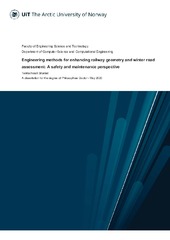| dc.contributor.advisor | Eltoft, Torbjørn | |
| dc.contributor.advisor | Graversen, Rune | |
| dc.contributor.advisor | Saper, Ronald | |
| dc.contributor.advisor | Dagestad, Knut-Frode | |
| dc.contributor.author | Baadshaug, Ole | |
| dc.date.accessioned | 2018-08-31T08:57:52Z | |
| dc.date.available | 2018-08-31T08:57:52Z | |
| dc.date.issued | 2018-06-29 | |
| dc.description.abstract | Moving icebergs represent a major problem for shipping, as well as for oil and gas installations in ice infested waters. To be able to take actions against hazardous icebergs, it is necessary to develop models for prediction of iceberg drift trajectories. Many models have been developed in order to do so, using different approaches. These approaches can be divided into two main categories, dynamic models and statistical models. The main difference between the approaches is that dynamic models forecast drift relying on the Newtonian equations utilizing forcing data, while the statistical models are based on an optimum statistical prediction using prior velocities to forecast the drift. This thesis will present the general physical and statistical theory iceberg drift models rely upon, and review a selection of different iceberg models. The main goal of this thesis is to evaluate the forecasting capabilities of two different iceberg drift models, implemented in a software module called OpenBerg. A model making accurate drift predictions could be utilized both operationally, and for research purposes. One of the models is a deterministic model, relying on dynamic equations. The other is a hybrid model which utilizes dynamic forecasting of components considered predictable (such as winds and tides), while modelling the residual component using statistical methods. To evaluate the software module, sensitivity studies were utilized to determine the effect of certain parameter choices. An ensemble analysis was performed on a selected track section, and the results were used to create confidence bounds for the predictions. | en_US |
| dc.identifier.uri | https://hdl.handle.net/10037/13617 | |
| dc.language.iso | eng | en_US |
| dc.publisher | UiT The Arctic University of Norway | en_US |
| dc.publisher | UiT Norges arktiske universitet | en_US |
| dc.rights.holder | Copyright 2018 The Author(s) | |
| dc.rights.uri | https://creativecommons.org/licenses/by-nc-sa/3.0 | en_US |
| dc.rights | Attribution-NonCommercial-ShareAlike 3.0 Unported (CC BY-NC-SA 3.0) | en_US |
| dc.subject.courseID | EOM-3901 | |
| dc.subject | VDP::Mathematics and natural science: 400::Geosciences: 450::Oceanography: 452 | en_US |
| dc.subject | VDP::Matematikk og Naturvitenskap: 400::Geofag: 450::Oseanografi: 452 | en_US |
| dc.subject | VDP::Mathematics and natural science: 400::Mathematics: 410::Statistics: 412 | en_US |
| dc.subject | VDP::Matematikk og Naturvitenskap: 400::Matematikk: 410::Statistikk: 412 | en_US |
| dc.subject | VDP::Mathematics and natural science: 400::Information and communication science: 420::Mathematical modeling and numerical methods: 427 | en_US |
| dc.subject | VDP::Matematikk og Naturvitenskap: 400::Informasjons- og kommunikasjonsvitenskap: 420::Matematisk modellering og numeriske metoder: 427 | en_US |
| dc.subject | VDP::Mathematics and natural science: 400::Information and communication science: 420::Simulation, visualization, signal processing, image processing: 429 | en_US |
| dc.subject | VDP::Matematikk og Naturvitenskap: 400::Informasjons- og kommunikasjonsvitenskap: 420::Simulering, visualisering, signalbehandling, bildeanalyse: 429 | en_US |
| dc.subject | VDP::Mathematics and natural science: 400::Mathematics: 410::Analysis: 411 | en_US |
| dc.subject | VDP::Matematikk og Naturvitenskap: 400::Matematikk: 410::Analyse: 411 | en_US |
| dc.subject | VDP::Mathematics and natural science: 400::Geosciences: 450 | en_US |
| dc.subject | VDP::Matematikk og Naturvitenskap: 400::Geofag: 450 | en_US |
| dc.title | Iceberg Drift-Trajectory Modelling and Probability Distributions of the Predictions | en_US |
| dc.type | Master thesis | en_US |
| dc.type | Mastergradsoppgave | en_US |


 English
English norsk
norsk



